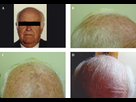This case in this late 2015 study quite impressed me / "Topical Diclofenac 3% Gel for Actinic Keratosis May Induce Terminal Hair in Male Androgenetic Alopecia: A Report of Three Cases"
http://webcache.googleusercontent.c...cle_id=33470+&cd=3&hair loss=fr&ct=clnk&gl=fr
-Diclofenac 3% was used for treating his actinic keratosis, so the topical application was on his AKs and not all over the balding scalp. ( and just once a day application)
-the guy is in his seventies, balding for more than 15 years and showed (after 6months) terminal hair growth (pic B and C) on non-prior haired areas of the scalp
-the photo D is a 4 years follow up "Patient 1 was followed-up for four years because of his AK, and showed continuous hair growth over the span of this period"
I'm seriously wondering what a 'twice a day application, during +12 months, and all over the scalp' could do?
This gel sounds nice and how it grow hair is not really surprising:
'Diclofenac 3% gel is a non-steroidal anti-inflammatory drug that inhibits COX-1 and COX-2 enzymes, resulting in decreased production of PGs and MMPs.'
'COX-2 has a key function in the prostaglandins pathway, converting AA to PGH2, from which PGD2, PGE2, PGF2α, prostacyclin and thromboxane A2 are produced by specific synthase enzymes'
'Authors hypothesize that the inhibition of the COX-2 by diclofenac, might act over the inflammatory mechanism and the PGs misbalance (↑PGD2, ↓PGE2, ↓PGF2α) observed in the Androgenetic Alopecia.'
___________
Recently topical 3% diclofenac is commonly used to treat actinic keratosis (AK) with good results (1). It may also have a potential effect on hair growth (2). Authors present three cases of hair growth on the scalp after topical diclofenac treatment. To the authors’ best knowledge, these are the first reported cases in the literature.
2.Case presentation
Three male patients were visited in the dermatology department because of scalp AK, and received treatment with topical 3% diclofenac gel-based drug compound, once nightly for four to six months. One gram of the gel was used on a 10 × 10 cm area. All patients were in their seventies (73, 77 and 79 years old) and had also concomitant androgenetic alopecia for more than 15 years. During the follow-up visits after four and six months of starting the treatment, all patients and their families described terminal hair growth on non-prior haired areas of the scalp. This finding was also observed by the authors (Figures 1 and 2). There were neither relevant previous interventions nor concomitant medications that could interfere in the outcome. Patient 1 was followed-up for four years because of his AK, and showed continuous hair growth over the span of this period (Figure 1). Treatment was well tolerated in all cases and no adverse events were observed.
some terminal hair for the 3 seventies guys! topical application that targeted their AK areas not all their hair loss area, and just once a day for 6 months. After 4 years those terminal hair on the subject 1 continue to grow
I would love to know what kind of results we could see with 3% diclofenac once or twice a day, for more than 12 months, all over the balding areas and miniaturized hair ( even on the donor area), and on younger cases than the 3 seventies ( 2 recent studies showed how cells power decreased with age)

